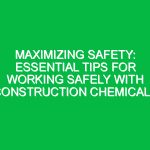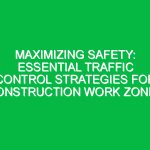In the realm of construction, navigating confined spaces is a critical challenge that demands meticulous planning, comprehensive training, and stringent adherence to Health Safety and Environment (HSE) protocols. These spaces, characterized by their limited entry and exit points and not designed for continuous occupancy, can pose significant risks to workers, including exposure to toxic substances, asphyxiation, and the danger of being trapped. This article delves into expert strategies for enhancing safety when working in these high-risk areas, ensuring that every project aligns with the highest standards of health and safety.
Understanding Confined Spaces in Construction
Before diving into the strategies, it’s crucial to grasp what constitutes a confined space in the construction industry. These are areas that are substantially enclosed (though not always entirely), where serious injury can occur from hazardous substances or conditions within the space or nearby (e.g., lack of oxygen).
Examples of Confined Spaces
- Tanks and vessels
- Silos
- Pits and trenches
- Pipes and ducts
- Access shafts
Key Strategies for Safe Navigation
Ensuring the safety of workers who enter confined spaces requires a multifaceted approach. Below are expert-recommended strategies that cover preparation, entry, work, and exit processes.
Comprehensive Risk Assessment
Performing a thorough risk assessment is the first step in confined space work safety. This involves identifying potential hazards, evaluating the risks associated with those hazards, and determining appropriate measures to control or eliminate them. Factors to consider include the nature of the space, the activities to be performed, and the potential for hazardous atmospheres.
Developing a Confined Space Entry Plan
A well-structured confined space entry plan is essential for ensuring that all safety measures are clearly defined and understood by all team members. This plan should include:
- The roles and responsibilities of the entry team
- Entry and exit procedures
- Emergency response procedures
- Communication protocols
Training and Equipping the Team
Workers must be adequately trained on the specific hazards of the confined space, the use of necessary equipment, and emergency procedures. This training should be both theoretical and practical, ensuring that workers can apply their knowledge effectively in real-world scenarios. Additionally, providing the right personal protective equipment (PPE) and ensuring its proper use is non-negotiable.
Monitoring Atmospheric Conditions
Many confined spaces present the risk of hazardous atmospheres, which can include toxic gases, flammable vapors, or insufficient oxygen levels. Continuous monitoring of these conditions is crucial, using appropriate detection equipment to ensure the safety of workers inside the space.
Implementing Rescue Procedures
Despite all precautions, emergencies can still occur. Having a well-defined and practiced rescue procedure is vital. This includes having rescue equipment readily available and ensuring that some team members are trained in rescue operations.
Technological Advances in Confined Space Safety
Advancements in technology have introduced new tools and equipment that significantly enhance safety in confined spaces. These include:
Wearable Technology
Wearable devices can monitor vital signs and environmental conditions in real-time, providing early warnings of potential health risks.
Remote Monitoring Systems
Drones and robotic devices can be used to enter confined spaces before humans, offering a preliminary assessment of the conditions without putting workers at risk.
Communication Tools
Modern communication tools enable constant contact between team members inside the confined space and those outside, ensuring that any issues can be promptly addressed.
Regulatory Compliance
Adhering to local and international HSE regulations is not just a legal requirement; it’s a moral imperative to ensure worker safety. Familiarity with and adherence to these regulations is essential for anyone involved in confined space work.
Conclusion
Navigating confined spaces in construction safely is a complex but manageable challenge. By understanding the risks, implementing comprehensive safety strategies, leveraging technology, and ensuring regulatory compliance, construction projects can minimize the hazards associated with confined spaces. Remember, the goal is not just to comply with safety standards but to create an environment where every worker returns home safely at the end of the day.
Summary of Key Points
- Confined spaces in construction pose significant risks.
- A comprehensive risk assessment is crucial.
- Developing a confined space entry plan is essential for safety.
- Training and equipping the team properly can save lives.
- Monitoring atmospheric conditions and implementing rescue procedures are vital safety measures.
- Technological advances can enhance confined space safety.
- Regulatory compliance is both a legal and moral imperative.


